.jpg)
Colors in Homeopathy
Color preference as a homeopathic symptom
Ulrich Welte and Markus Kuntosch
Direct link to Color-Remedy List and to Remedy-Color-List
Similarity is the essence of homeopathy: Homeopathy selects appropriate remedies according to the principle of similarity. A remedy should be as similar as possible to the state known as illness; it should have a “remedy picture” not just of the objective symptoms of the illness but it should also be as similar as possible to the overall illness state. This includes changes in behaviour and the individual state of mind.
Three main elements determine the homeopathic procedure: casetaking, repertorisation and remedy selection. Homeopathic casetaking is an extended form of the general diagnostic assessment used in medicine. In the overview one analyses all essential aspects that can finally lead to the selection of the most similar remedy. This can certainly be difficult since the selection of remedies is often huge but only a few are so similar to the illness state that they are effective when administered homeopathically. One can “repertorise” the key symptoms of the illness so that there is less need to pore over the homeopathic tomes. The repertory provides us with remedy recommendations fitting the symptoms. From these recommendations we can then proceed to select the single best, most similar remedy.
An example: A woman is complaining of vertigo associated with nausea and the urge to vomit; the vertigo and the overall state improve when she closes her eyes. One can repertorise these signs of illness (= symptoms) and then compare the recommended potential remedies matching these symptoms. This looks as follows:

In our repertorisation Conium comes first: The two symptoms vertigo with nausea and vertigo on closing eyes amelioration show us a list of indicated remedies (Con, Ferr, Acon…) from most to least likely, based on these symptoms. Con is the abbreviation for Conium, hemlock, Ferr for Ferrum, iron, Petr for Petroleum, Tab for tobacco etc. Anyone familiar with these remedy pictures can see from these proposed remedies further similarities between remedy and patient.
Maybe the patient had always been anaemic since her youth and repeatedly needed iron supplements. In this case we would look more closely at Ferrum, the second proposed remedy, for her vertigo. Or the patient may be a wizened old woman without a husband, who is already sclerotic or showing signs of dementia: Conium would then be the first choice. Or the patient may have literary interests plus insomnia who has been looking after her ill husband for several years: Cocculus at number seven would then be the most likely remedy, even though it does not cover the second symptom “vertigo on closing eyes amel.”.
The remedies of homeopathy speak the same language as the illnesses: one can directly compare remedy picture and illness picture. This is one of the decisive characteristics of homeopathy and it is this simple comparison that makes homeopathy so practical. The remedy knowledge does not come from some pathophysiological preconception, as in the allopathic “hypertension remedies” or “antibiotics” and is also not primarily oriented to reducing fat or blood sugar levels or whatever. Rather it consists of remedy pictures. Healthy subjects, usually homeopathic doctors themselves, have tested on themselves and others how the remedies feel and what their effect is on living, sentient people. These “provings” are written down in comprehensive reference works. These were originally just collections of symptoms originating in the remedy provings. This jungle of symptoms was, however, difficult to learn – yet the remedy pictures have evolved over the last 200 years in an encouraging direction. They are now more understandable and so easier to learn. But above all the original proving symptoms have become more accessible with the advent of computer repertorisation software, which can easily digest enormous quantities of data, documenting thousands of remedies from hundreds of large reference works, delivering the desired results at the click of a mouse.
Color preference is a characteristic symptom. As we can see, not just symptoms such as “vertigo on closing eyes amel.” lead to the remedy selection but also the patient’s general characteristics and their individual state of mind; indeed this can be even more important than individual illness symptoms. Color preference is one such general characteristic. It reflects the basic mood of the patient, their “individual frequency”, and this resonates especially when we administer a corresponding remedy. The homeopathic remedies only heal chronic illnesses in particular when they can generate a resonance due to their similarity to the patient’s basic vibration. Therefore we only need such a small dose to generate an effect. Yet even in acute illness it is advantageous to select from the small set of similar remedies the one with a similar color preference. More on this below.
Color preference can profitably be compared to the modalities that were so clearly delineated by Clemens von Bönninghausen and that now play a central role in the method called polarity analysis developed by Heiner Frei. These are also not the local external signs of illness such as “vertigo” or “nausea” but rather the movements of the living organism that seek to compensate the unease via specific measures such as closing the eyes, modifying temperature effects like cold or warmth, or mechanical impacts such as pressure or stretching etc.
Black is the color of Conium: If a certain color preference clearly emerges and it is consistently verified over a longer time period, it can be used as a general characteristic of the patient. Let us assume that someone prefers black. Then the most similar remedy will usually be found in the rubric black: Color-Remedy List.
We see in this rubric, for example, most plants of the hemlock family (Umbelliferae, Apiaceae) as well as other remedies such as Graphite, Silver or Titanium. Conium, hemlock, is a particularly poisonous variant of the Apiaceae, which caused the death of Socrates. The description of his death from a cup of hemlock was written down by his pupil Plato, providing a relatively accurate remedy picture of Conium, which causes rising paralysis with full consciousness until the moment of death.
Conium as the birth of the color symptom: Socrates not only died from the poison of the hemlock but was also indirectly associated with the emergence of the homeopathic color symptom. He liked to see himself as the midwife of new ideas, even effective 2500 years later, and indeed it was a Conium patient who triggered the Cologne internist and prior lung specialist Dr Hugbald Volker Müller (1921 – 2000) to think of color selection as a homeopathic symptom. The patient said he always felt especially well and his symptoms also improved when he went for a walk at night in the darkness. He also said that he particularly liked the color black. Müller then checked other patients who he had healed with Conium to see whether they too preferred the color black – and found that this was true for several other patients, especially those for whom the remedy had generated a particularly profound positive reaction. So the idea was born that other remedies might also have a common color preference, which was later confirmed.

H.V. Müller at the age of 80
The practical application of the symptom color: To be able to work scientifically with this idea, however, he needed a validated standardisation of the colors – for example, something like the Pantone or RAL color system, such as printers use. Müller chose as his measurement tool the “Taschenlexikon der Farben” (“Pocketbook of Colors”) from Kornerup and Wanscher, since it was very comprehensive and included the grey tones, although these turned out to be more of a hindrance than a help. The last edition of the Taschenlexikon was published in 1981 and has long been available only from antiquarian booksellers. With this system he began to define the color preference of all his patients. Many patients who were healed with the same remedy picked not just a similar color but the exact same one from a potential palette of 1266 color tones.
Yet Müller soon realised that the precision of a specific remedy in a particular defined color field could certainly differ. He therefore extended the area of each remedy to several color fields. At this point in time we had already established close contact with him and were swapping experiences.
At this time I began to develop my own color system that incorporated these observations, tailored specifically to homeopathic applications. When I first went to see Müller in 1993 he was immediately enthusiastic and said this was precisely the right approach and I should definitely follow this through to publication. The best homeopathic publishers at that time, however, insisted on publishing with four-color offset printing because it is cheaper than printing with true colors. But this would have caused falsification of many colors, as I quickly realised using the Pantone formula guide. So publication was delayed. Unfortunately Dr Müller died in the year 2000 before he could self-publish it. So in 2003 we decided that in view of the difficulties – especially since Haug Verlag declined to publish the book in the requested print quality – we should publish it ourselves. This was the only way open to us to implement the high quality standards required for accurate color printing.
So the rejected color book led to the founding of Narayana Verlag in its current form and, over the course of the next 10 years it advanced in the face of all resistance to become the leading homeopathic publisher in Germany.
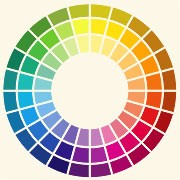
The new color standard “Colors in Homeopathy” published in 2003
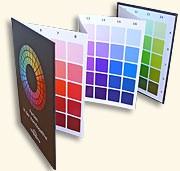 This year saw the first publication of the color atlas Colors in Homeopathy. This work is now available in five languages and is currently available in the greatly expanded seventh edition. The color preference has become a valuable additional symptom in the homeopathic materia medica. The color repertory is used successfully around the world, independently of the various schools of homeopathy as an additional criterion in remedy selection.
This year saw the first publication of the color atlas Colors in Homeopathy. This work is now available in five languages and is currently available in the greatly expanded seventh edition. The color preference has become a valuable additional symptom in the homeopathic materia medica. The color repertory is used successfully around the world, independently of the various schools of homeopathy as an additional criterion in remedy selection.
The international cooperation of competent homeopaths has enabled us to greatly expand the number of color-defined remedies. H.V. Müller in the year 2000 left a core group of 460 remedies, which has now grown to approximately 1200, twice as many as were listed in the first edition of the color book. It is very gratifying to note the high number of independent confirmations of the color definitions. Many homeopaths report that they can use the color symptom to successfully prescribe “minor” remedies, which they would otherwise not have considered. These contributions have also enabled us to modify or supplement the previous color classifications.
A constantly growing list of color relationships is now freely available. This is frequently updated and can be printed off by anyone who is interested, ensuring that their color repertory is always right up-to-date: link to Color-Remedy List.
Comment from our website by Jörg J. Müller
Thanks to a rare coincidence, a few days before the publication of the German version of this Homeonews we received this review of our color book:
Pay attention to the mind symptom “favourite color”!
Since in homeopathy we are not treating illnesses but patients who have developed specific symptoms that are similar to a homeopathic remedy picture, there will not be THE remedy for a case of Covid-19. As with anything else, we must individualise when treating this illness. First of all we should consider the patient’s color preference – their “favourite color” – as the most significant mind symptom. With this we can exclude remedies right from the start in our differential diagnosis. This method was developed and pioneered for homeopathy by Prof. Dr. Hugbald Volker Müller (1921 - 2000, doctor of homeopathy from Cologne), validated with hundreds of cases over more than 45 years. The wildly popular sold-out remedy Camphora will especially help people whose favourite color is crimson red (13-14 AB 8 according to H.V. Müller or 11C according to U. Welte) or orange (6C according to U. Welte). Grindelia patients choose black, Chininum muriaticums choose pink (9A) or red (9C). Further remedies named so far in connection with the pandemic include: Bryonia (olive-green: 1-3DE), Kalium carbonicum (bright blue: 15-16C), Lycopodium (black-blue: 15-16E), Mercurius sol. (dark blue-green: 19DE) and Phosphorus (bright green: 20-22C). Homeopaths who are not yet working with the color preference but who have already had success treating Covid-19 patients should subsequently check their patients’ color preference! I think they will be astonished and it will be a great help to share their experiences. (Color table from Ulrich Welte: Colors in Homeopathy, Narayana Verlag.)
|
|
Colors in HomeopathyColor preference as a homeopathic symptom Ulrich Welte and Markus Kuntosch Direct link to Color-Remedy List and to Remedy-Color-List Similarity is the essence of homeopathy: Homeopathy selects appropriate remedies according to the principle of similarity. A remedy should be as similar as possible to the state known as illness; it should have a “remedy picture” not just of the objective symptoms of the illness but it should also be as similar as possible to the overall illness state. This includes changes in behaviour and the individual state of mind. Three main elements determine the homeopathic procedure: casetaking, repertorisation and remedy selection. Homeopathic casetaking is an extended form of the general diagnostic assessment used in medicine. In the overview one analyses all essential aspects that can finally lead to the selection of the most similar remedy. This can certainly be difficult since the selection of remedies is often huge but only a few are so similar to the illness state that they are effective when administered homeopathically. One can “repertorise” the key symptoms of the illness so that there is less need to pore over the homeopathic tomes. The repertory provides us with remedy recommendations fitting the symptoms. From these recommendations we can then proceed to select the single best, most similar remedy. An example: A woman is complaining of vertigo associated with nausea and the urge to vomit; the vertigo and the overall state improve when she closes her eyes. One can repertorise these signs of illness (= symptoms) and then compare the recommended potential remedies matching these symptoms. This looks as follows:
In our repertorisation Conium comes first: The two symptoms vertigo with nausea and vertigo on closing eyes amelioration show us a list of indicated remedies (Con, Ferr, Acon…) from most to least likely, based on these symptoms. Con is the abbreviation for Conium, hemlock, Ferr for Ferrum, iron, Petr for Petroleum, Tab for tobacco etc. Anyone familiar with these remedy pictures can see from these proposed remedies further similarities between remedy and patient. Maybe the patient had always been anaemic since her youth and repeatedly needed iron supplements. In this case we would look more closely at Ferrum, the second proposed remedy, for her vertigo. Or the patient may be a wizened old woman without a husband, who is already sclerotic or showing signs of dementia: Conium would then be the first choice. Or the patient may have literary interests plus insomnia who has been looking after her ill husband for several years: Cocculus at number seven would then be the most likely remedy, even though it does not cover the second symptom “vertigo on closing eyes amel.”. The remedies of homeopathy speak the same language as the illnesses: one can directly compare remedy picture and illness picture. This is one of the decisive characteristics of homeopathy and it is this simple comparison that makes homeopathy so practical. The remedy knowledge does not come from some pathophysiological preconception, as in the allopathic “hypertension remedies” or “antibiotics” and is also not primarily oriented to reducing fat or blood sugar levels or whatever. Rather it consists of remedy pictures. Healthy subjects, usually homeopathic doctors themselves, have tested on themselves and others how the remedies feel and what their effect is on living, sentient people. These “provings” are written down in comprehensive reference works. These were originally just collections of symptoms originating in the remedy provings. This jungle of symptoms was, however, difficult to learn – yet the remedy pictures have evolved over the last 200 years in an encouraging direction. They are now more understandable and so easier to learn. But above all the original proving symptoms have become more accessible with the advent of computer repertorisation software, which can easily digest enormous quantities of data, documenting thousands of remedies from hundreds of large reference works, delivering the desired results at the click of a mouse. Color preference is a characteristic symptom. As we can see, not just symptoms such as “vertigo on closing eyes amel.” lead to the remedy selection but also the patient’s general characteristics and their individual state of mind; indeed this can be even more important than individual illness symptoms. Color preference is one such general characteristic. It reflects the basic mood of the patient, their “individual frequency”, and this resonates especially when we administer a corresponding remedy. The homeopathic remedies only heal chronic illnesses in particular when they can generate a resonance due to their similarity to the patient’s basic vibration. Therefore we only need such a small dose to generate an effect. Yet even in acute illness it is advantageous to select from the small set of similar remedies the one with a similar color preference. More on this below. Color preference can profitably be compared to the modalities that were so clearly delineated by Clemens von Bönninghausen and that now play a central role in the method called polarity analysis developed by Heiner Frei. These are also not the local external signs of illness such as “vertigo” or “nausea” but rather the movements of the living organism that seek to compensate the unease via specific measures such as closing the eyes, modifying temperature effects like cold or warmth, or mechanical impacts such as pressure or stretching etc. Black is the color of Conium: If a certain color preference clearly emerges and it is consistently verified over a longer time period, it can be used as a general characteristic of the patient. Let us assume that someone prefers black. Then the most similar remedy will usually be found in the rubric black: Color-Remedy List. We see in this rubric, for example, most plants of the hemlock family (Umbelliferae, Apiaceae) as well as other remedies such as Graphite, Silver or Titanium. Conium, hemlock, is a particularly poisonous variant of the Apiaceae, which caused the death of Socrates. The description of his death from a cup of hemlock was written down by his pupil Plato, providing a relatively accurate remedy picture of Conium, which causes rising paralysis with full consciousness until the moment of death. Conium as the birth of the color symptom: Socrates not only died from the poison of the hemlock but was also indirectly associated with the emergence of the homeopathic color symptom. He liked to see himself as the midwife of new ideas, even effective 2500 years later, and indeed it was a Conium patient who triggered the Cologne internist and prior lung specialist Dr Hugbald Volker Müller (1921 – 2000) to think of color selection as a homeopathic symptom. The patient said he always felt especially well and his symptoms also improved when he went for a walk at night in the darkness. He also said that he particularly liked the color black. Müller then checked other patients who he had healed with Conium to see whether they too preferred the color black – and found that this was true for several other patients, especially those for whom the remedy had generated a particularly profound positive reaction. So the idea was born that other remedies might also have a common color preference, which was later confirmed.
H.V. Müller at the age of 80
The practical application of the symptom color: To be able to work scientifically with this idea, however, he needed a validated standardisation of the colors – for example, something like the Pantone or RAL color system, such as printers use. Müller chose as his measurement tool the “Taschenlexikon der Farben” (“Pocketbook of Colors”) from Kornerup and Wanscher, since it was very comprehensive and included the grey tones, although these turned out to be more of a hindrance than a help. The last edition of the Taschenlexikon was published in 1981 and has long been available only from antiquarian booksellers. With this system he began to define the color preference of all his patients. Many patients who were healed with the same remedy picked not just a similar color but the exact same one from a potential palette of 1266 color tones. Yet Müller soon realised that the precision of a specific remedy in a particular defined color field could certainly differ. He therefore extended the area of each remedy to several color fields. At this point in time we had already established close contact with him and were swapping experiences. At this time I began to develop my own color system that incorporated these observations, tailored specifically to homeopathic applications. When I first went to see Müller in 1993 he was immediately enthusiastic and said this was precisely the right approach and I should definitely follow this through to publication. The best homeopathic publishers at that time, however, insisted on publishing with four-color offset printing because it is cheaper than printing with true colors. But this would have caused falsification of many colors, as I quickly realised using the Pantone formula guide. So publication was delayed. Unfortunately Dr Müller died in the year 2000 before he could self-publish it. So in 2003 we decided that in view of the difficulties – especially since Haug Verlag declined to publish the book in the requested print quality – we should publish it ourselves. This was the only way open to us to implement the high quality standards required for accurate color printing. So the rejected color book led to the founding of Narayana Verlag in its current form and, over the course of the next 10 years it advanced in the face of all resistance to become the leading homeopathic publisher in Germany.
The new color standard “Colors in Homeopathy” published in 2003
The international cooperation of competent homeopaths has enabled us to greatly expand the number of color-defined remedies. H.V. Müller in the year 2000 left a core group of 460 remedies, which has now grown to approximately 1200, twice as many as were listed in the first edition of the color book. It is very gratifying to note the high number of independent confirmations of the color definitions. Many homeopaths report that they can use the color symptom to successfully prescribe “minor” remedies, which they would otherwise not have considered. These contributions have also enabled us to modify or supplement the previous color classifications. A constantly growing list of color relationships is now freely available. This is frequently updated and can be printed off by anyone who is interested, ensuring that their color repertory is always right up-to-date: link to Color-Remedy List. Comment from our website by Jörg J. MüllerThanks to a rare coincidence, a few days before the publication of the German version of this Homeonews we received this review of our color book: Pay attention to the mind symptom “favourite color”!Since in homeopathy we are not treating illnesses but patients who have developed specific symptoms that are similar to a homeopathic remedy picture, there will not be THE remedy for a case of Covid-19. As with anything else, we must individualise when treating this illness. First of all we should consider the patient’s color preference – their “favourite color” – as the most significant mind symptom. With this we can exclude remedies right from the start in our differential diagnosis. This method was developed and pioneered for homeopathy by Prof. Dr. Hugbald Volker Müller (1921 - 2000, doctor of homeopathy from Cologne), validated with hundreds of cases over more than 45 years. The wildly popular sold-out remedy Camphora will especially help people whose favourite color is crimson red (13-14 AB 8 according to H.V. Müller or 11C according to U. Welte) or orange (6C according to U. Welte). Grindelia patients choose black, Chininum muriaticums choose pink (9A) or red (9C). Further remedies named so far in connection with the pandemic include: Bryonia (olive-green: 1-3DE), Kalium carbonicum (bright blue: 15-16C), Lycopodium (black-blue: 15-16E), Mercurius sol. (dark blue-green: 19DE) and Phosphorus (bright green: 20-22C). Homeopaths who are not yet working with the color preference but who have already had success treating Covid-19 patients should subsequently check their patients’ color preference! I think they will be astonished and it will be a great help to share their experiences. (Color table from Ulrich Welte: Colors in Homeopathy, Narayana Verlag.) |
Spectrum of Homeopathy
|
||||||




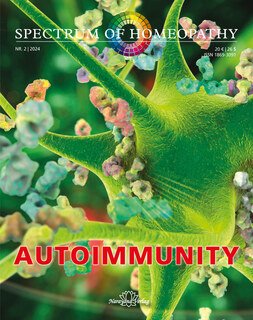

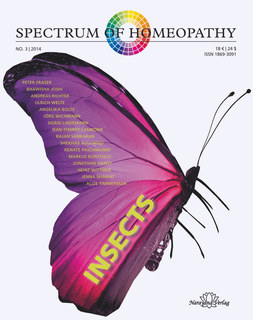
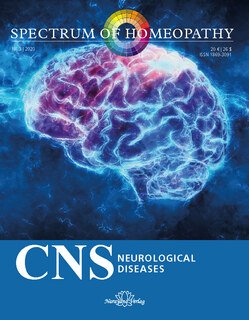

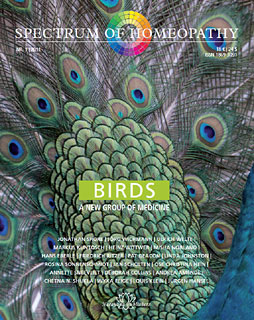
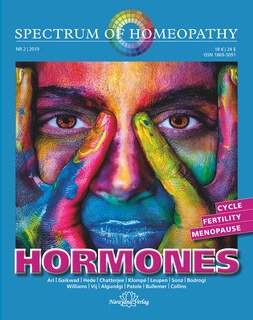
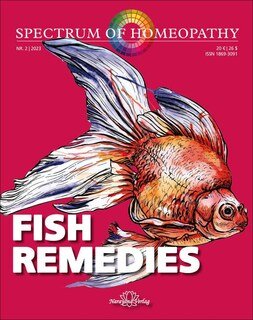
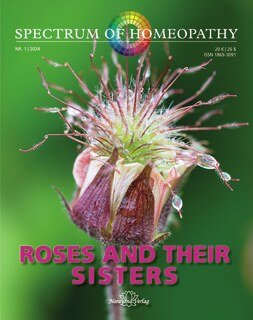
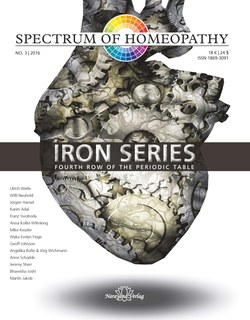
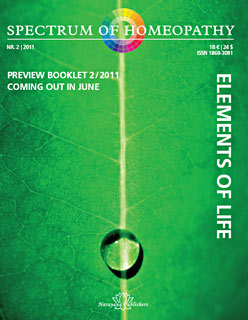

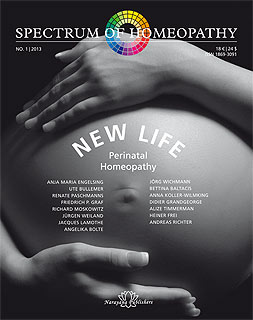

 back to list
back to list

